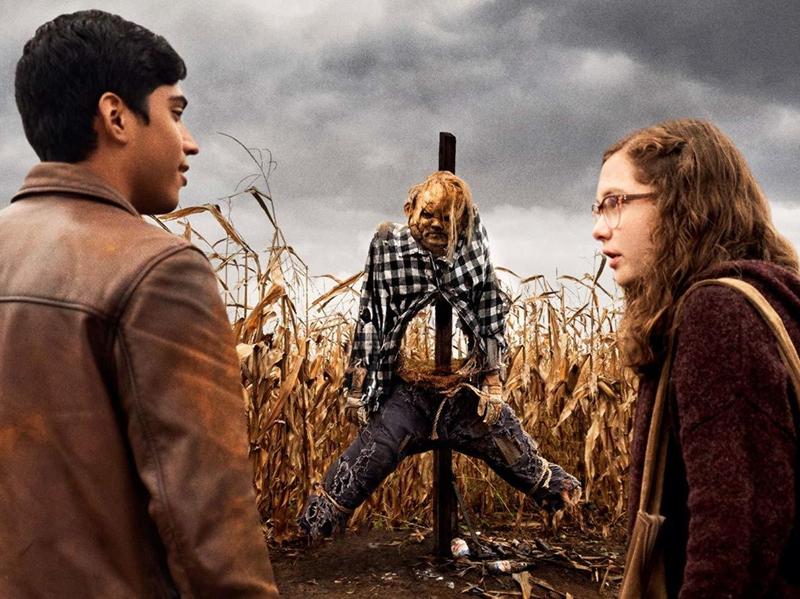'Scary Stories To Tell In The Dark' Puts The BOO! In Book Adaptation

The pictures are probably what you remember: shrieking witches and half-melted skulls leering out from jet-black pages; hideous creatures snarling on leashes; and tree branches lurching like tentacles from tombstones. These were the defining images of the Scary Stories To Tell In The Dark books, which began haunting the children's section of your local library in 1981, although the stories themselves were based on centuries-old urban legends and folktales that have plagued various cultures for far longer. Such was the nightmarish power of their author, Alvin Schwartz, and original illustrator Stephen Gammell, that if a skittish parent tried to ban one book from the shelves, three more would spring up in its place overnight.
The book at the center of this new PG-13 Scary Stories film adaptation operates under the same rules. Recovered from its resting place in the local haunted house in suburban Pennsylvania, it's leather-bound and filled with gory, unseemly tales scrawled in children's blood. And the stories write themselves, in this case literally. The book can't be returned or destroyed, and its various ghouls (who bear strong visual resemblances to Gammell's drawings) are trying to kill the teenagers who conjure them — including a horror-obsessed loner (Zoe Margaret Colletti) and a Mexican drifter passing through town (Michael Garza). Given all this, it's a nice touch that even when things get bad, these kids are still reading the stories to each other. As the Crypt Keeper might say, they're just dying to know what happens next.
Scary Stories was produced and shepherded to the screen by Guillermo del Toro, one of the few filmmakers alive who figured out how to turn an unabashed love of creepy genre pictures into awards-lined mainstream success. It's not surprising that he loved these books as a kid; the dude loved anything that would make him howl in terror. But though he took a pass on the script (he's credited as a co-writer along with Lego Movie scribes Dan and Kevin Hageman), del Toro handed off directing duties to his Trollhunter pal André Øvredal, who has delivered a more meat-and-potatoes horror picture geared toward older teens who might or might not have vague memories of the books from their youth. Don't worry, though. The spiders are still here.
The obvious problem with adapting the Scary Stories is that most of the individual tales were only a page or two long, and they didn't have much in the way of arcs or morals; they typically ended with a suggestion to scream the final lines at your friends in a spooky voice. The fun was in the telling, and you were meant to fill in the blanks in your own imagination. This is a hard thing to do in the movies. Even the horror genre, which can make you hold your breath by showing absolutely nothing at all, must eventually smack you with the spook, which Scary Stories does time and time again, to diminishing returns.
But in the meantime, the set-pieces are often smartly realized, with tension that builds in fits and waves, hooking audiences in for big communal frights. A showdown with a bug-covered scarecrow in a rustling cornfield is a highlight, as is another with a clever creature who can drop down a chimney one severed body part at a time.
It's important to enjoy these sequences, repetitive though they eventually become, because the technique with which they're made is what holds the production together. Narratively, the film isn't quite able to tap into the rich vein of campfire folklore it might have found had it embraced an anthology format. Instead, letting teens loose in a period setting (it takes place in 1968, in the witching-hour period between Halloween and Richard Nixon's Election Day) becomes a clumsy effort to capture some Stranger Things magic. You especially feel this in its lazy characterization of supporting players/victims like the group's official prankster (Austin Zajur) and the cerebral nerd (Gabriel Rush).
The premise itself, meanwhile, borrows from the far noisier 2015 kid-horror hit Goosebumps. There's some family business scattered around, too, involving a miller's heiress falsely accused of grisly acts who begins writing the creepy stories as an act of revenge ... lending credence to the theory that these books were written by an angry ghost to scare children.
Above all, the film celebrates storytelling as both a healing and a harming force, a way for us to put a face on something as unknowable as death. And if Øvredal and del Toro struggle at getting these tales to burrow under our skin in a figurative sense, at least they can do it literally.
9(MDEwODYxNTQyMDEzNjAxODk2Nzc2NzNmYQ001))